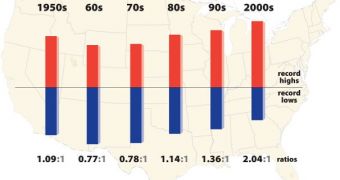In spite of the fact that many choose to refuse the idea that global warming and climate change exist, it is nevertheless happening, as satellite data and meteorological measurements show. Speaking of the latter, the National Science Foundation (NSF) reports that a recent study showed a massive discrepancy between the number of record high temperatures and record low ones. This is further evidence that global warming not only exists, but also affects the climate of the country directly. The new research compared the average daily temperatures for this year with the average ones from the last decade.
“This intriguing study provides new evidence of climate change. And it's change that's affecting our daily lives,” reveals Steve Nelson. He is the NSF program director for the Boulder, Colorado-based National Center for Atmospheric Research (NCAR). In addition to the experts from this institution, other authors of the new paper include scientists from the US National Oceanic and Atmospheric Administration (NOAA), Climate Central, and The Weather Channel. The research will appear in print in an upcoming issue of the respected scientific journal Geophysical Research Letters, a publication of the American Geophysical Union (AGU).
The investigators add that, if emissions of greenhouse gases such as carbon dioxide and methane continue to rise at the current pace, the ratio of record highs to lows will continue to increase as well. “Climate change is making itself felt in terms of day-to-day weather in the United States. The ways these records are being broken show how our climate is already shifting,” explains the lead author of the new paper. NCAR scientist Gerald Meehl. Funding for the investigation came from the NSF, Climate Central, and from the US Department of Energy (DOE).
“If the climate weren't changing, you would expect the number of temperature records to diminish significantly over time. As you measure the high and low daily temperatures each year, it normally becomes more difficult to break a record after a number of years. But as the average temperatures continue to rise this century, we will keep setting more record highs,” adds Climate Central statistician Claudia Tebaldi, who is also a coauthor of the research.
“One of the messages of this study is, you still get cold days. Winter still comes. Even in a much warmer climate, we're setting record low minimum temperatures on a few days each year. But the odds are shifting so there's a much better chance of daily record highs instead of lows,” Meehl concludes.

 14 DAY TRIAL //
14 DAY TRIAL //